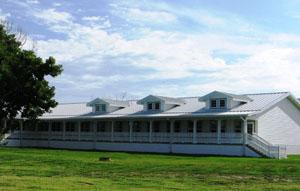Facility Resiliency at EPA

One of EPA’s Gulf Ecology Division laboratory facilities in Gulf Breeze, Florida, was designed to shield the building from severe weather events.
EPA works to mitigate the effects of severe weather events by reducing greenhouse gas emissions from its facilities and operations. EPA also recognizes the need to enhance the resiliency of the Agency’s facilities to adapt to extreme weather events. A series of Facility Adaptation Plans focus on protecting Agency facilities and operations from the impacts of weather and other events.
The Agency performs resiliency assessments at its laboratories that are most vulnerable to the impacts of extreme weather events. EPA uses these assessments to improve the resiliency and readiness of facilities and operations and limit future damages and costs associated with extreme weather events.
Assessments
EPA conducted pilot resiliency assessments in different regions of the country to account for the diversity of extreme weather event stressors. Each assessment employed a checklist of facility planning and design best practices from other federal agencies; industry literature; and state and local building regulations, codes and ordinances.
EPA’s assessments identified local and regional extreme weather event stressors, interviewed facility staff and focused on the following facility-specific considerations:
- Below-grade areas
- Mechanical and electrical systems
- Facility construction details
- Utility systems
- Stormwater infrastructure
These assessments helped EPA facilities note existing efforts to mitigate extreme weather event impacts, identify vulnerabilities that could be further exacerbated by extreme weather events, "ground truth" best practices for facility resiliency and identify opportunities for enhancing facility resiliency to extreme weather event stressors.
